Bmw X5 F15 2013 -2018 - used, experience, problems
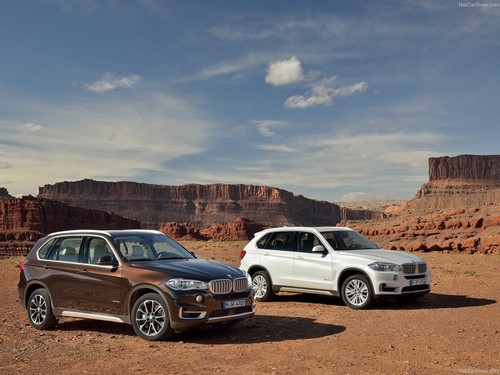
Connoisseurs of the classic “X5” brutal shapes may be frustrated by the new look of the crossover, as the car has acquired some “feminine” features, more dynamic side lines, front and rear design with design elements from current BMW models, as well as sporty air vents at the front edges. bumper. On the other hand - the look of the Bmw X5 F15 2014-2015 model year has become more modern and closer to the new design standards of the Bavarian car manufacturer.
In terms of dimensions bmw There were no noticeable changes to the X5 F15: the length was extended by 32 mm to the level of 4886 mm, the wheelbase remained at 2933 mm, the width increased by 5 mm to 1938 mm and the height was 1762 mm, which is 13 mm less than its predecessor. Due to the increased use of aluminum and other lighter materials, the car's weight decreased by an average of 90 kg and the aerodynamic coefficient of braking of the body was improved from 0,33 to 0,31. Both parameters significantly influenced the dynamic characteristics of the crossover.
The interior bmw The X5 crossover has changed significantly more noticeably. The new architecture of the F15's front panel brings it closer to the modern style of the German carmaker, while tightening its ergonomics. The quality of the material used in the interior has become even better. Visibility from the driver's seat did not change much, as the glass pattern remained virtually unchanged, but the side mirrors became slightly smaller, increasing the amount of blind spots.
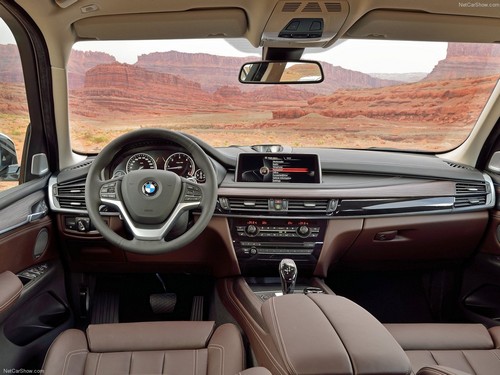
Useful storage space in the third generation of the crossover is noticeably larger than the previous one. In standard condition, the boot contains 650 liters, but thanks to the rear row of seats, which folds in a 40:20:40 ratio, it can be increased to 1870 liters, not counting the floor space.
As for the quality of driving on paved roads, the crossover has added virtually nothing, but the ability of cars on the roads has been noticeably reduced. The reason for this is the short movement of the suspension and the reduction of the height of the vehicle (from 222 mm to 209 mm), which makes the bottom of the vehicle easily hooked. The crossover is still equipped with an xDrive all-wheel drive system based on electro-control.
Still very fresh looking, the third-generation Bmw X5 was available not only with the xDrive 4-wheel drive system, but also as a rear-wheel drive (sDrive) car, unlike its predecessor, which had only four-wheel drive. Of course we can speculate if the rear-wheel drive only makes sense, but I don't have time for that.
Bmw X5 F15 - Engines
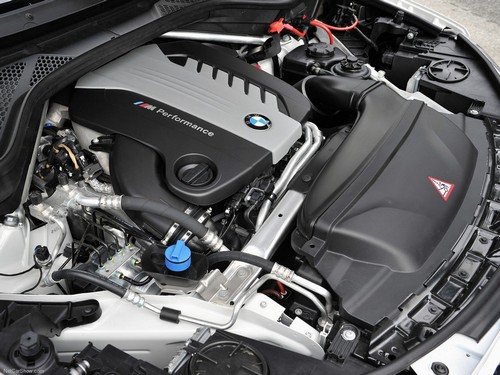
The engine range on the Bmw X5 F15 is very extensive. Even those picky will find something for themselves.
The role played by the base unit designed for the modified xDrive35i. It has 6 cylinders with a displacement of 3,0 liters (2979 cm³), with 24 valves, direct fuel injection and a turbocharger. The maximum power of the youngest gasoline engine is 306 hp, developed at 5800 rpm, but the highest torque is about 400 Nm, maintained in the range of 1200 to 5000 rpm. The xDrive35i can accelerate from 0 to 100 km / h in 6,5 seconds or reach 235 km / h at top speed, consuming about 8,5 liters of gasoline per 100 km.
The hybrid version - xDrive40e has also been on offer since 2015. It has a 2-liter turbo-four-cylinder engine from the N20 family with 245 hp and an electric motor with 113 hp. It provides very good performance (6,8 s to 100 km / h), but the petrol unit may have problems with the operation of the oil pump.
The top versions of the xDrive50i and X5 M feature a 8-liter twin-turbo V4,4 engine. It looks to be the same unit, but the xDrive50i has a N63 engine and 450 hp, while the X5 M has a strengthened S63 and 575 hp. The lower version accelerates to 100 km / h in 5 s, and stronger in 4,2 s. Unfortunately for the 7-Series F01 and 5-Series F10, the 4,4-liter V8 engine, after running over 100 km, starts consuming too much engine oil, the nozzles are defective, the piston rings need to be replaced, and in some cases even the head it cracks. Whether the problems are solved in the X000 F5, time will tell.
The diesel engine range opens with the xDrive25d version (in some markets, there was a sDrive25d rear-drive variant as well). In models manufactured to August 2015 under this designation, there is a 2-liter N47 engine generating 218 hp, which accelerates to 100 km / h in 7,7 s. Unfortunately, this design suffers from problems with a stretch chain. As of August 2015, the N47 engine replaced the two-liter B47 engine with 231 hp (a car with such an engine accelerates to 100 km / h in 6,9 s). So far, no work issues.
xDrive30d are equipped with an in-line diesel engine N57 D30 with six cylinders with a volume of 2993 cm³ and a power of 249 hp at 4000 rpm. The engine is no longer new, well established, but has undergone a major upgrade. In particular, the injection pressure is increased (from 1600 to 1800 bar), the engine weight is reduced, and the operation of almost all electronic controls is adjusted. We also note that the diesel engine is equipped with a new variable geometry turbocharger, third-generation injection and Bosch piezoelectric nozzles. The engine torque has been brought to the level of 560 Nm at 1500 - 3000 rpm, which will enable acceleration from 0 to 100 km / h in just 6,9 seconds, while the upper speed limit will be 230 km / h. According to the manufacturer, the average consumption of this engine is around 6,2 liters.
Versions are also available with the N6 3-cylinder, 57-liter engines. The xDrive30d variant has one turbocharger and produces 258 hp. The xDrive40d version with two turbochargers has 313 hp and the upper X5 M50d with three turbochargers and 381 hp. For now, car users are not complaining about the failure rate of these units. However, it should be borne in mind that the more turbochargers the more expensive the repair costs are in the event of potential failures.
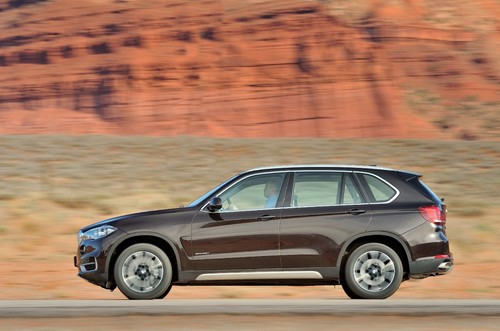
Bmw X5 F15 - problems and malfunctions
Obviously, if you want to keep your car for a long time without major maintenance costs, then choose the right 6-cylinder turbocharged engine that is the most reliable gasoline engine. It is not advisable to buy a hybrid version without an extended warranty, but if you really want it, then at least make sure the hybrid battery is in good condition.
There is an electronically adjustable steering column that can stop working. There are a number of cases where only half of the adjustment has worked - which can be caused by a faulty steering adjustment motor.
If you cruise regularly at higher speeds, then it is definitely good to check for wind noise. So, mostly if you are traveling at a speed of 140 or 150 km / h or more, then you can hear a continuous or only a short occasional wind noise, mostly if the weather is also windy. This wind noise is like a door opening a little short or like a slightly open door window. All this is usually caused by incorrectly adjusted doors, mostly on the driver's side. If you feel this wind noise, you can try to adjust the door a bit - which will mostly solve the problem. But you can check in another way: Just accelerate to the speed of the highway, and then try to push the door a little - if you do not hear excessive wind noise, the door adjusts properly and if the wind noise increases significantly, then you have a badly adjusted door.
Running iDrive or other minor electronic problems may occur mainly on earlier models, but these problems are usually resolved by software updates.
There are several cases where one of the doors suddenly unlocks after you hit an opening, or it can sometimes happen if you lean too hard on the door. In other words, the door will not open completely, it will only open as unlocked if you do not close the door properly. This is not very common, but it has mostly happened on some early production cars manufactured by 2014 and was caused by a faulty door lock, so occasionally after the change it was fixed.
As with other cars, check for water leaks in the interior and avoid cars with a panoramic roof, unless you forget to periodically clean the water drain from the roof, as there are already cases of clogged roof water drains that will obviously cause water leaks inside. Keep the area under the windshield and near the hinges of the lid clean, as leaves and dirt may accumulate over time.
All gasoline engines may occasionally have more or less problems with leaks resulting from defective coils, injectors or defective high pressure fuel pumps.
Some plastic hoses can break here and there, but more often with V8 engines. In fact, you should especially check the plastic crankcase vent hoses on this V8 that are located under the plastic bonnet to the right above the two turbochargers. Because turbochargers produce a large amount of heat, these hoses can burst and cause unwanted fire, whistling and a small oil leak. BMW replaced these hoses, so they are no longer made of plastic, but of rubber, and their replacement is not difficult - on the other hand, they are also not very cheap.
The 4.4 l twin turbo V8 is a better / updated version, so it's not the infamous unreliable earlier version made with other luxury Bmws before 2013. With proper maintenance it can withstand 200 km, but I would not recommend buying this engine after this mileage, since afterwards it is likely to increase the chances of various failures (such as leaks, oil consumption, soot buildup and other problems).
It is also good to check whether oil or coolant leaks mainly on the 4-liter V4,4, because in some rare cases they can appear even after 60 km.
It is definitely important to maintain the correct oil level all the time, as a 4,4 l V8 can consume less or more oil.
When it comes to diesel engines, it doesn't really matter which one you choose. But to minimize most problems, you should use your car mostly on longer journeys, and it is also very important that you use high quality fuel.
Bmw X5 Second-hand Price List - Second-hand view
Recommendation of similar texts:

Hi there, I am Mladen and I am an auto enthusiast. I started this blog years ago to help like minded people share information about latest cars, car servicing ideas, used car info, exotic cars, and auto technology. You will find helpful articles and videos on a wide variety of cars - Audi, Mercedes, Toyota, Porsche, Volvo, BMW and much more. Ping us if you have anything cool to share on latest cars or on how to make older cars more efficient, or just want to say hi!




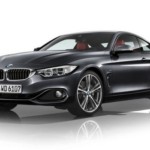
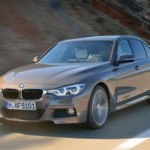

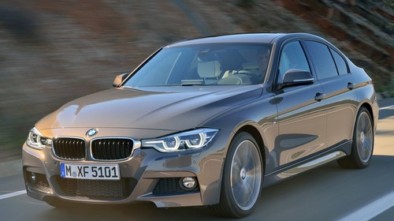
The interior is so good that I would forgive him for any problems. 😀
Dear Mladen, would you still tell someone who is in love with a model, after all the problems, not to hesitate?